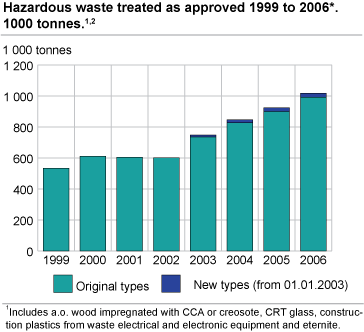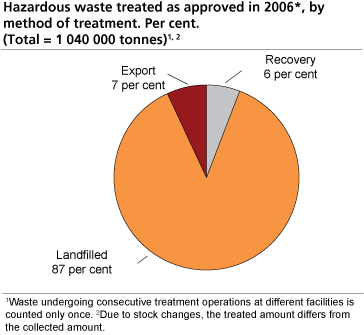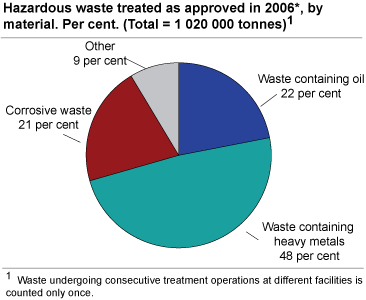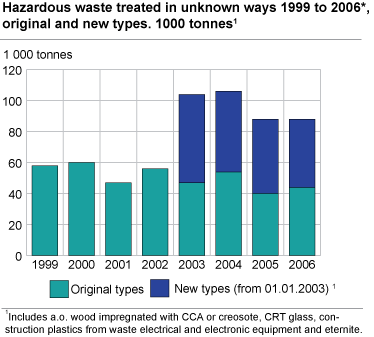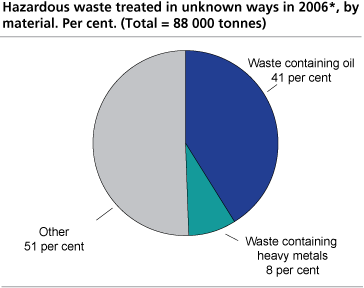Content
Published:
This is an archived release.
1 million tonnes to approved treatment
Slightly more than 1 million tonnes of hazardous waste were treated by approved means in 2006, of which nearly half contained heavy metals. The amount handled in unknown ways has been reduced by 16 per cent in four years.
When handled incorrectly, hazardous waste may be harmful to human health and the environment. The Norwegian government’s national target is that all hazardous waste shall undergo approved treatment. Moreover, the total amount of hazardous waste shall be no higher in 2020 than in 2005.
Rise in hazardous waste to approved treatment
In total, 1 020 000 tonnes of hazardous waste were treated at approved facilities in 2006. This is an increase of 90 000 tonnes, or 9 per cent, from the previous year. The largest increase took place within waste containing heavy metals, while other types of waste decreased by 7 per cent. It is assumed that only 60 per cent of the general rise is due to a real growth in waste amounts, while the remaining may be explained by improved data collection (see box 1).
From 2003 to 2006, the amount of waste treated by approved means rose by 36 per cent. Waste containing heavy metals had the strongest increase, but for this period the other waste types showed a general increase of 12 per cent. Improved data collection also explains a significant part of the rise.
6 per cent of the amount treated by approved means were recovered in Norway, and a similar share were recovered abroad. About 10 000 tonnes were exported for disposal, of which 90 per cent contained oil or solvents and were sent for incineration.
Waste containing heavy metals, principally slag from manufacturing, was the predominant material type in 2006, accounting for nearly half the waste total. Oil-containing waste and corrosive waste (acids and bases) made up slightly more than 20 per cent each. Three of five tonnes of waste with a known sector of origin originated from the manufacturing industries.
Decline in unknown handling
In 2006, 88 000 tonnes of hazardous waste were treated in unknown ways. This is 1 per cent less than in 2005 and 16 per cent less than in 2003. A number of waste types previously classified as ordinary were classified as hazardous as of 1 January 2003, including impregnated wood and plastics containing brominated flame retardants. This explains the increase in waste treated in unknown ways from 2002 to 2003. With these new types of hazardous waste being excluded, the amount of hazardous waste treated in unknown ways fell by 26 per cent from 1999 to 2006. Not all hazardous waste handed in for approved treatment is registered correctly. Hence, parts of the 88 000 tonnes may be treated as approved.
Oil-containing waste amounted to 36 000 tonnes in 2006, or 41 per cent of the amount being handled in unknown ways, a decline of 8 per cent from 2003. The amount of windows with PCBs handed in correctly increased to 2 300 tonnes in 2006 from near nil in 1999. Meanwhile the generated amount decreased. This means that practically all windows of this kind are taken properly care of. The amount of impregnated wood waste being handled in unknown ways comprised 32 000 tonnes in 2006. The main part was sleepers, poles, etc. impregnated with creosote, and much of it is believed to be reused in private gardens and along paths.
Tables:
- Table 1 Hazardous waste registered for approved treatment 1999-2006 and total amount treated as approved 2003-2006. 1 000 tonnes
- Table 2 Hazardous waste treated as approved 1999 to 2006, by material. 1 000 tonnes
- Table 3 Hazardous waste to unknown handling 1999 to 2006, original and new types. 1 000 tonnes
- Table 4 Hazardous waste to unknown handling 1999 to 2006, by material. 1 000 tonnes
- Table 5 Hazardous waste treated as approved 2003 to 2006, by method of treatment. 1 000 tonnes
- Table 6 Hazardous waste treated as approved 1999 to 2006, by industry. 1 000 tonnes
Additional information
Approved treatment as applied in this article includes only hazardous waste generated in Norway (export is therefore included, while import is excluded).
Contact
-
Gisle Berge
E-mail: gisle.berge@ssb.no
tel.: (+47) 48 12 19 97
-
Terje Lorentzen Landsem
E-mail: terje.landsem@ssb.no
tel.: (+47) 98 84 31 39

